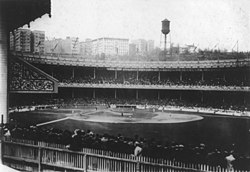
Back Polo Grounds CEB Polo Grounds Czech Polo Grounds German Polo Grounds Spanish Polo Grounds Basque Polo Grounds French Polo Grounds Italian ポロ・グラウンズ Japanese 폴로 그라운즈 Korean Polo Grounds Portuguese
"The Bathtub" | |
 Polo Grounds IV during the 1913 World Series (New York Giants and Philadelphia Athletics) (below) Site of the original Polo Grounds, 1876–1888, between 110th and 112th Street, Manhattan | |
 | |
| Former names | Brotherhood Park (adjacent to Polo Grounds II, 1890) Brush Stadium (1911–1919) |
|---|---|
| Location | bounded by West 155th Street, Frederick Douglass Blvd. and Harlem River Drive in Washington Heights, Manhattan, New York City |
| Coordinates | 40°49′54″N 73°56′14″W / 40.83167°N 73.93722°W Polo Grounds III (1891–1963) 40°49′49″N 73°56′16″W / 40.83028°N 73.93778°W Polo Grounds II/Manhattan Field (1889–1890/1891–1948) 40°47′53″N 73°57′2″W / 40.79806°N 73.95056°W Polo Grounds I (1876–1889) |
| Owner | New York Giants |
| Operator | New York Giants |
| Capacity | 34,000 (1911) 55,000 (1923) |
| Field size | Left field: 279 ft (85 m) Left-center: 450 ft (137 m) Center field: 483 ft (147 m) Right-center: 449 ft (136 m) Right field: 258 ft (78 m)  |
| Surface | Grass |
| Construction | |
| Broke ground | 1890 |
| Opened | April 19, 1890 |
| Renovated | June 28, 1911 |
| Expanded | 1923 |
| Closed | December 14, 1963 |
| Demolished | April 10, 1964[1][2] |
| Architect | Henry B. Herts |
| Tenants | |
| New York Metropolitans (AA) (1883) New York Giants (PL) (1890) New York Giants (NL) (1891–1957) New York Giants (ALPF) (1894) New York Yankees (AL) (1913–1922) New York Mets (NL) (1962–1963) New York Brickley Giants (NFL) (1921) New York Giants (NFL) (1925–1955) Columbia Lions football (NCAA) (1900–1922) New York Nationals (ASL) (1927–1930) Fordham Rams football (NCAA) (1928–1950; 1953–1954) New York Giants (ASL) (1930–1932) New York Cubans (NNL) (1939–1950) New York Black Yankees (NNL) (1931–46) New York Bulldogs (NFL) (1949) New York Titans/Jets (AFL) (1960–1963) Gotham Bowl (NCAA) (1961) | |
The Polo Grounds was the name of three stadiums in Upper Manhattan, New York City, used mainly for professional baseball and American football from 1880 to 1963. The original Polo Grounds, opened in 1876 and demolished in 1889, was built for the sport of polo. Bound on the south and north by 110th and 112th streets and on the east and west by Fifth and Sixth (Lenox) avenues, just north of Central Park, it was converted to a baseball stadium when leased by the New York Metropolitans in 1880.
The third Polo Grounds, built in 1890, and renovated after a fire in 1911, was in Coogan's Hollow and was noted for its distinctive bathtub shape, with very short distances to the left and right field walls and an unusually deep center field.
The original Polo Grounds was home to the New York Metropolitans from 1880 to 1885, and the New York Giants from 1883 to 1888. The Giants played in the second Polo Grounds for part of the 1889 season and all of the 1890 season, and at the third Polo Grounds from 1891 to 1957. The Polo Grounds was also the home of the New York Yankees from 1913 to 1922 and New York Mets in their first two seasons (1962, 1963). Each version of the ballpark held at least one World Series. The final version also hosted the 1934 and 1942 All-Star Games.
In American football, the third Polo Grounds was home to the New York Brickley Giants for one game in 1921 and the New York Giants from 1925 to 1955. The New York Titans/Jets of the American Football League played at the stadium from the league's inaugural season of 1960 until 1963.
Other sporting events held at the Polo Grounds included soccer, boxing, and Gaelic football. Its final sporting event was a pro football game between the Jets and Buffalo Bills. Shea Stadium opened in 1964 and replaced the Polo Grounds as the home of the Mets and Jets. The Polo Grounds was demolished and a public housing complex, Polo Grounds Towers, built on the site.[1]
- ^ a b "Historic old Polo Grounds to be torn down–finally". Lewiston Morning Tribune. (Idaho). Associated Press. April 9, 1964. p. 13.
- ^ "Walls tumble down at Polo Grounds". Pittsburgh Press. UPI. April 10, 1964. p. 35.